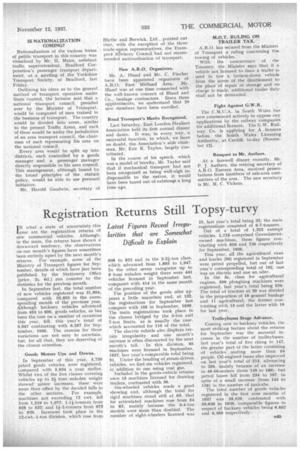Registration Returns Still Topsy-turvy
Page 29

If you've noticed an error in this article please click here to report it so we can fix it.
IN what a state of uncertainty this year are the registration returns of new commercial vehicles. Although, in the main, the returns have shown a downward tendency, the observations on one month's figures have sometimes been entirely upset by the next month's returns. For example, some of the Ministry of Transport figures for September, details of which have just been published by the Stationery Office (price, -2s. 6d.) run counter to the statistics for the previous month.
In September last, the total number of new vehicles registered was 31,994, compared with 32,835 in the corresponding month of the previous year. Although hackney vehicles advanced from 453 to 600, goods vehicles, as has been the case on a number of occasions this year, fell, this year's total of 6,047 contrasting with 6,297 for September, 1936. The reasons for these variations are not easy to ascertain, but, for all that, they arc deserving of the closest attention.
Goods Motors Ups and Downs.
In September of this year, 5,7:39 petrol goods vehicles were registered, compared with 5,934 a year earlier. Whilst two of the five classes covering vehicles up to 2f tons unladen weight showed minor increases, these were more than offset by the decided falls in the other sections. For example, machines not exceeding 12 cwt. fell from 1,219 to 1,077; 1-1i-tonners from 628 to 532; and I1-2-tonners from 972 to 920. Increases took place in the 12-cwt.-1-ton division, which rose from 808 to 822 and in the 2-21-ton class, which advanced from 1,893 to 1,947. In the other seven categories up to 9 tons unladen weight there were 441 vehicles licensed in September last, compared with 414 in the same month of the preceding year.
The position of the goods oiler appears a little uncertain and, at 132, the registrations for September last compare with 155 in September, 1936. The main registrations took place. in the classes bridged by the 3-ton and 7-ton limits, as is usually the case, which accounted for 110 of the total.
The electric vehicle also displays certain irregularity and one month's increase is often discounted by the next month's fall. In this division, 65 machines were licensed in September, 1937, last year's comparable total being 91. Under the heading of steam-driven vehicles, we find six vehicles registered, in addition to one using coal gas.
Included in the goods-vehicle returns were 13 machines licensed for drawing trailers, contrasted with 36.
Six-wheeled vehicles made a good showing and, although the total for rigid machines stood still at 63, that for articulated machines rose from 54 to 88, mainly because the 3-4-ton models were more than doubled. The number of eight-wheelers licensed was 25, last year's total being 32; the main registrations consisted of 6-7-tonners.
Out of a total of 1,322 exempt vehicles, 1,218 comprised Governmentowned machines, these figures con' trOsting with 859 and 736 respectively for September, 1936.
This year, all the agricultural_ vans and lorries (96) registered in September were petrol propelled, but out of last year's corresponding total of 102, one was an electric and one an oiler.
In the 5s. class for agricultural engines, 599 ploughing machines were registered, last year's total being 529. The total of tractors at 29 was divided in the proportion of 18 general haulage and 11 agricultural, the former contrasting with 13 and the latter with 10 for last year.
Trolleybuses Stage Advance.
Coming now to hackney vehicles, the most striking feature about the returns for September was the material increase in the number of trolleybuses, last year's total of five rising to 147, the greater part of the latter consisting of vehicles seating more than 64 people. Oil-engine(' buses also improved on last year's total of 214, advancing to 256, mainly because of an increase in 48-56-seaters (from '149 to 189), but petrol buses fell from 234 to 197, in spite of a small increase (from 145 to 158) in the number of taxicabs.
The total number of goods vehicles registered in the first nine months of 1937 was 58,520, contrasted with 59,838 in 1936, comparable 'figures in respect of hackney vehicles being 6,652 and 6,350 respectively.








































